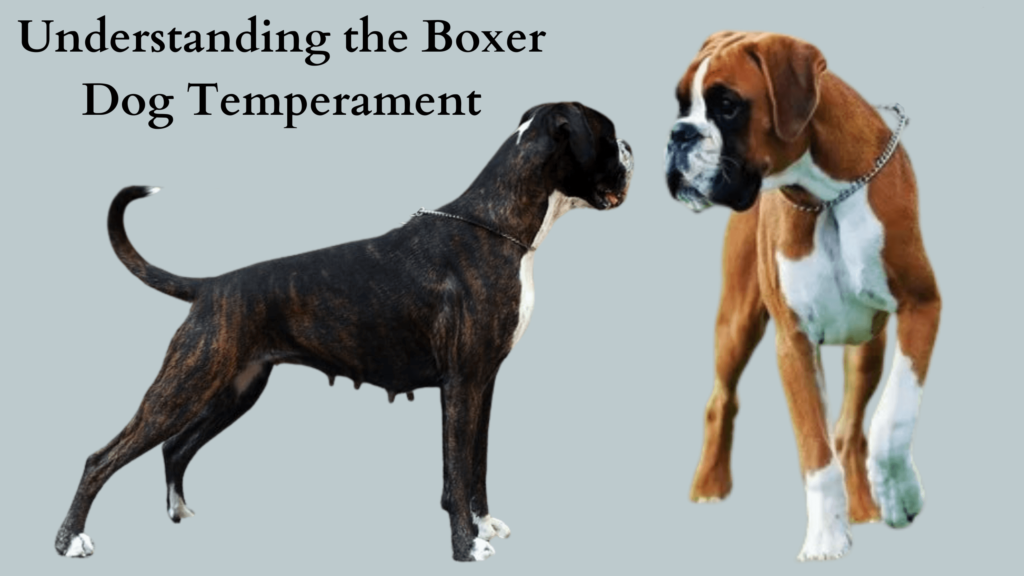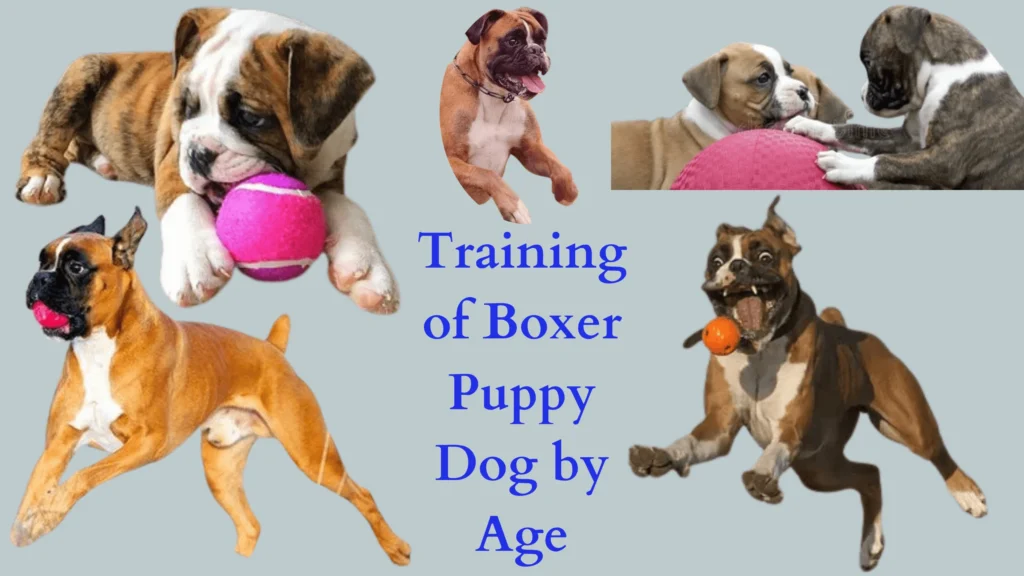Bringing house a fresh boxer puppy is an exciting adventure but it can certainly be a fragile procedure when you already have an adult Boxer. Introducing a brand new puppy to your Boxer is approached carefully and patience to make certain a harmonious commitment between your two puppies. In this extensive guide, we will protect all you need to learn about launching your new Boxer puppy to your current boxer furry family member. We will also guide you that how to Introduce a Boxer Puppy to Adult Dog.
Understanding the Boxer Dog Temperament:
Before diving to the introduction process, let’s explore the Boxer’s temperament. Boxers are notable for their particular happy-go-lucky characters, making them great companions for people and other pets. They are usually good with young ones, cats, along with other dogs, particularly Boxer puppies. However, it’s essential to recognize that Boxers also provide protective instincts due to their record as searching and battling puppies. We’re provided some key points to understanding the boxer puppy temperament:

Aggression Potential:
While Boxers are often friendly, their particular protective nature can sometimes trigger hostility. Understanding your own Boxer’s puppy behavior around various other puppies is vital.
Health insurance and Well-Being:
A Boxer that feels unwell or perhaps is in pain may react differently to a different puppy. Make sure your adult Boxer is healthy and comfortable.
Gender Dynamics:
Launching opposite-sex puppies tends to be smoother. However, same-sex introductions can work well too with appropriate planning.
Importance of Boxer Puppy Dog in your Life:
Boxer puppies tend to be more than just adorable bundles of fur buddy. They bring a unique blend of qualities which make all of them exceptional friends. Keep in mind that every Boxer dog is exclusive so adapt your treatment and training to accommodate their particular individual needs. From their puppy mischief with their safety instincts Boxers bring heat and laughter to any house.
Loyalty and Protection:
- Boxers are fiercely faithful for their people. Their safety instinct makes them exceptional defense puppies.
- They’ll fearlessly safeguard their loved ones making all of them a dependable choice for security alarm.
Playful and Silly Nature:
- Behind those dark eyes lies an environment of playfulness. Boxer puppies light any space they enter.
- Their ridiculous antics and boundless energy bring delight to households.
Therapy Dogs and Search-and-Rescue Heroes:
- Boxers have actually a great work ethic. They serve as therapy dogs providing convenience and company to those in need.
- Their particular agility and determination also cause them to become important members of search and boxer rescue teams.
Natural Fit with Children:
- Boxers adore children. Their particular sweet nature and persistence make them ideal playmates for little ones.
- They thrive in family surroundings and form strong bonds with kids.
Unique Appearance:
- With expressive eyes, a square-shaped head, and a confident gait Boxers have actually a unique look.
- Their quick, smooth fur will come in brindle or fawn colors with white markings.
Minimal Grooming Needs:
- Boxers tend to be naturally clean puppies. Their brief layer calls for minimal grooming.
- Regular brushing encourages a streamlined and shiny look.
Vigilant and Alert:
- Boxers remain aware of their surroundings. Their wrinkled foreheads provide the dogs them a permanent “at attention” look.
- They are confident and ready to protect their family when needed.
Introducing to Boxer Puppy to Adult Dog:
Preparation and Planning:
- Understand Your Boxer: Understand your Boxer’s socialization record and any triggers or challenges they might have.
- Fragrance Swapping: Before the physical conference, swap fragrances between your puppy and Boxer. Use covers or toys with each dog’s aroma and put all of them within the various other puppies environment.
The First Meeting:
- Neutral Territory: Select a natural area for initial introduction. Avoid your home or your Boxer’s normal area.
- Managed Interaction: hold both puppies on leashes and enable them to see one another from a safe length. Gradually lessen the length while you feel much more comfortable.
- Great Associations: Reward soothe behavior with snacks and praise. Eliminate any negative communications.
Supervised Interactions:
- Short Sessions: Keep the initial interactions brief to prevent overwhelm.
- Gradual Exposure: Over several days increase the time they spend together. Monitor closely for signs of stress or aggression.
- Separate Spaces: Provide separate resting areas for each dog to retreat to when needed.
Body Language and Signals:
- Watch Closely: Observe their body language. Signs of tension include stiff postures, growling, or raised hackles.
- Positive Signs: Wagging tails, relaxed bodies, and play bows indicate positive interactions.
Positive Reinforcement:
- Treats and Praise: Reward both dogs when they interact calmly and positively.
- Consistency: Be consistent in your approach and maintain patience.
Long-Term Monitoring:
- Months, Not Days: Continue monitoring interactions for several weeks or even months until you’re confident in their relationship.
- Gradual Integration: Slowly allow them to spend more time together without constant supervision.
Growing Stages of a Boxer Puppy by Age:
Bringing home a Boxer puppy is a lot like welcoming big money of joy to your life. These lively, affectionate puppies are known for their particular playful antics and unwavering loyalty. As the small Boxer puppy grows, you will witness different developmental phases that shape their character and real characteristics. Let’s explore the development trip of a Boxer puppy from beginning to adulthood.

Neonatal Stage (Birth to 2 Weeks):
- At birth: The boxer puppies weigh around 2.5 to 3.2 pound. They are blind, deaf and totally dependent on their mother.
- Warmth and Nourishment: During this stage, they rely on their mother’s milk for sustenance and warmth. Their primary activities involve sleeping and nursing.
Transitional Stage (2 to 4 Weeks):
- Eyes available: All over 2nd week their particular eyes begin to open up, revealing the world around all of them.
- Wobbly methods: They start trying their very first wobbly actions, checking out their surroundings.
- Weaning phase: By the 4th few days, Boxer puppies are often weaned from their particular mother’s milk and started on tough meals.
Socialization Stage (4 to 12 Weeks):
- Exploration and training: this can be a crucial period for socialization. Boxer puppies become interested in every little thing. They study on communications with littermates, people, as well as other pets.
- Weight Gaining: Boxers can to have their particular loads triple with this growth duration, going from 2.5-3.5 kg at delivery to 2.5-3.5 kg at 12 days.
- Playtime Galore: They take part in play, practice biting, and develop their particular motor skills.
Ranking Stage (3 to 6 Months):
- Establishing Hierarchy: Boxer puppies start understanding their place in the family pack. They may challenge authority and test boundaries.
- Teething Troubles: Their baby teeth fall out, making way for adult teeth. Provide appropriate chew dog toys to soothe their gums.
Adolescence Stage (6 to 24 Months):
- Physical Growth: Boxers dogs to continue to grow in height and weight. Females are 21-24 inches long and reach 55-65 pounds, while males are 22-25 inches long and average 60-70 pounds.
- Mental Maturity: Their personalities solidify, and they become more independent.
- Energy Burst: Adolescents have boundless energy. The regular exercise and also mental stimulate are important to avoid the boredom.
Training Stage of Boxer Puppy Dog by Age:
Bringing house a Boxer puppy is a thrilling adventure but it also comes with responsibilities. Proper puppy training is vital to make certain your Boxer matures to-be a well-behaved and happy partner. Allow dive in to the various stages of Boxer puppy training and just how to set your dog up to achieve your goals.

Early Training (8–10 Weeks):
Local plumber to begin training your Boxer puppy is just about 8 to 10 days old. At this age, they’re highly receptive to new experiences and will find out basic commands. Right here is what you should concentrate on in this phase:
Socialization:
- Introduce your pup to friendly men and women and other puppies. Proper socialization is vital for Boxers that are fiercely safety of their boxer owners.
- Enroll in the AKC brand new Family puppy system to give organized socialization possibilities. Most education clubs accept a new puppies who are only eight months old if they have gotten their particular first shots.
Grooming Familiarization:
- Get the Boxer dogs familiar with fundamental grooming. Even though they have actually short-hair, numerous Boxers drool.
- Wipe their muzzle and dewlaps carefully with a dampened washcloth to clean up drool.
- Connect brushes and washcloths with good incentives (like snacks and praise) in order to make grooming a positive experience.
Basic Obedience Commands:
- Start teaching basic obedience commands: “Sit,” “Stay,” and “Come.”
- Channel their energy into positive behaviors. Boxers were originally bred to hunt large prey so prevent destructive habits by providing mental stimulation and training.
Puppy Stage (Up to 6 Months):
By this age, your Boxer pup dog need:
- Made new human and canine friends through socialization.
- Mastered basic obedience commands.
- Become comfortable with regular grooming.
Adult Boxer Dog (6 to 24 Months):
- Real development: Boxers continue steadily to grow high and body weight. Females tend to be 21-24 inches lengthy and achieve 55-65 weight, while males tend to be 22-25 inches lengthy and typical 60-70 weight typical.
- Mental Maturity: Their particular characters solidify plus they become more independent.
- Energy Burst: teenagers have boundless energy. A typical exercise regime and mental tasks are essential to reduce the risk of boredom.
Also Read: https://thepetlive.com/baby-boxer-dog-cost/
Conclusion:
Introducing an innovative new puppy to a Boxer needs cautious planning and perseverance. Start with a slow and methodical few days of interaction. Mindful direction is really important in the first couple weeks. Through these actions and watching your dog’s behavior, it is possible to produce a strong basis for a harmonious commitment.
Understand your Boxer’s temperament and how he responds with other puppies. First impressions are extremely important, therefore prepare your introductions accordingly. Don’t let the Boxer feel threatened or declined by the newcomer. As time passes and careful observance, those two boxer dogs can become companions and greatest buddies.
Remember that perhaps the sweetest Boxer cannot straight away accept a newcomer. The every puppy is exclusive, therefore adapt the process to your Boxer’s specific requirements. Eventually and good support, you may be Boxer additionally the new puppy becomes lifelong playmates and greatest friends.
Frequently Asked Question:
How do you introduce a puppy to a Boxer?
Introduce them gradually over a number of times, ensuring safe communications and close supervision. By considering the boxer’s temperament and preventing feelings to be threats or pressured, you set the tone for an excellent commitment.
How do you bond with a Boxer puppy?
A bond through benefits based training, using food and interest. Be completely engaged during interactions, learn their body language, and establish routines. Spend a lot period collectively to create trust and comprehension.
How can you introduce an infant to a Boxer?
Before the baby arrives, let your Boxer sniff a blanket using the infant fragrance. When presenting all of them, maintain control, enable safe sniffing, and monitor interactions closely.
How do you control a Boxer puppy?
Begin boxer education early, making use of obvious instructions and benefits. Consider positive support, specifically food benefits. Embrace the training process, comprehend their body language, and establish routines.
At what age is a Boxer no further a puppy?
Boxers usually change out of puppyhood around 12 to 18 months. But individual development is variable so keep an eye on your boxer’s behavior and real development maturity.
What is the most readily useful age to obtain a Boxer puppy?
The perfect age to create house a Boxer puppy is about 8 to 12 months. Early socialization and understanding are very important during this period.
Are Boxers very easy to teach?
Yes, Boxers are intelligent and lively. Use rewards-based instruction, show patience, and keep maintaining consistency. Their focus and look after food makes them extremely trainable.
Is Boxer good first dog?
While Boxers tend to be affectionate and playful, their energy level and protective instincts require commitment. With dogs in the correct manner training and appropriate socialization. They may be outstanding ideas companion, but simply take into severe consideration your experience and way of life.










